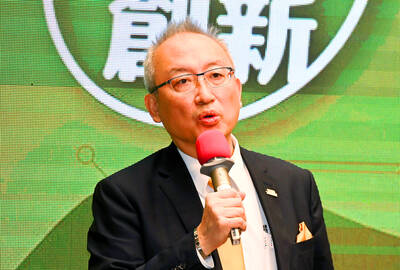Plans for a military museum that is being built in Taipei have drawn criticism for focusing on the military’s roots in China rather than Taiwan’s local history.
The National Military Museum, which is undergoing construction in the city’s Zhongshan District (中山), is to demonstrate the history of the nation’s armed forces from its inception in China to the modern age, a Ministry of National Defense report to the Legislative Yuan said.
The historical narrative is to be composed of three parts, starting with the military’s founding in China, its activities through the Cold War after its retreat to Taiwan and the armed forces in the modern age, the report said.

Photo courtesy of the Ministry of National Defense
The narrative’s silence about Taiwan’s military history prior to the arrival of Chinese nationalist forces reflects the tension between settler and localist historiography that continues to cause strife in Taiwan, Hung Chih-wen (洪致文), former chairman of the Taiwan Railway Museum Preparatory office, said on Tuesday.
The military understandably wishes to maintain the narrative that its history began with the Whampoa Military Academy in China, but having a museum that overlooks parts of Taiwanese history would create blind spots, said Hung, a professor at National Taiwan Normal University’s Department of Geography.
The museum would not address wars predating the retrocession that had a profound effect on Taiwanese historical experience, which should be the aim of a national-level military museum, he said.
Another subject that the museum overlooks is the presence of US military bases in Taiwan that changed so many lives, he said.
“The National Military Museum needs to decide if it is a museum for the armed forces alone or one that explores the impact of military activity on the entire society,” he said.
The planned museum lacks a critical perspective on the history of Whampao, and the military’s participation in atrocities and human rights violations during the White Terror era, Lo said.
That the uniform of major-general Peng Meng-chi (彭孟緝) — who ordered troops to fire on civilians in Kaohsiung during the 228 incident — would be on display at the museum shows that its planners refuse to confront the negative aspects of the military’s history, he said.
The armed forces have done a lot of good for the nation, but it would not truly be a Taiwanese military until it acknowledges its past mistakes, he said.

Actress Barbie Hsu (徐熙媛) has “returned home” to Taiwan, and there are no plans to hold a funeral for the TV star who died in Japan from influenza- induced pneumonia, her family said in a statement Wednesday night. The statement was released after local media outlets reported that Barbie Hsu’s ashes were brought back Taiwan on board a private jet, which arrived at Taipei Songshan Airport around 3 p.m. on Wednesday. To the reporters waiting at the airport, the statement issued by the family read “(we) appreciate friends working in the media for waiting in the cold weather.” “She has safely returned home.

Twenty-four Republican members of the US House of Representatives yesterday introduced a concurrent resolution calling on the US government to abolish the “one China” policy and restore formal diplomatic relations with Taiwan. Led by US representatives Tom Tiffany and Scott Perry, the resolution calls for not only re-establishing formal relations, but also urges the US Trade Representative to negotiate a free-trade agreement (FTA) with Taiwan and for US officials to advocate for Taiwan’s full membership in the UN and other international organizations. In a news release announcing the resolution, Tiffany, who represents a Wisconsin district, called the “one China” policy “outdated, counterproductive

A Vietnamese migrant worker on Thursday won the NT$12 million (US$383,590) jackpot on a scratch-off lottery ticket she bought from a lottery shop in Changhua County’s Puyan Township (埔鹽), Taiwan Lottery Co said yesterday. The lottery winner, who is in her 30s and married, said she would continue to work in Taiwan and send her winnings to her family in Vietnam to improve their life. More Taiwanese and migrant workers have flocked to the lottery shop on Sec 2 of Jhangshuei Road (彰水路) to share in the luck. The shop owner, surnamed Chen (陳), said that his shop has been open for just

MUST REMAIN FREE: A Chinese takeover of Taiwan would lead to a global conflict, and if the nation blows up, the world’s factories would fall in a week, a minister said Taiwan is like Prague in 1938 facing Adolf Hitler; only if Taiwan remains free and democratic would the world be safe, Deputy Minister of Foreign Affairs Francois Wu (吳志中) said in an interview with Italian newspaper Corriere della Sera. The ministry on Saturday said Corriere della Sera is one of Italy’s oldest and most read newspapers, frequently covers European economic and political issues, and that Wu agreed to an interview with the paper’s senior political analyst Massimo Franco in Taipei on Jan. 3. The interview was published on Jan. 26 with the title “Taiwan like Prague in 1938 with Hitler,” the ministry